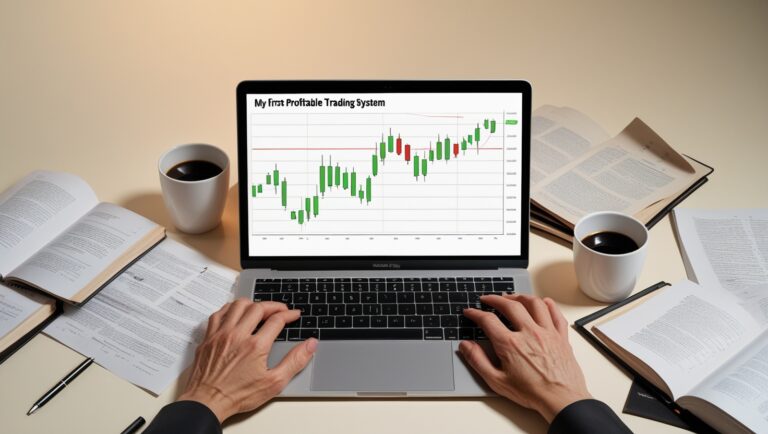How to Start Investing Safely in Volatile Markets
How to Start Investing Safely in Volatile Markets
Markets feel shaky? Learn how to start investing safely in volatile markets with beginner-friendly strategies, risk management tips, and the tools I personally use to protect my money.

Table of Contents
I’ll never forget the first time I invested during a volatile market. Prices were swinging up and down daily, headlines screamed about uncertainty, and honestly—I was scared. But I learned something important: volatility doesn’t mean you can’t invest. In fact, if you approach it the right way, it can create opportunities.
If you’re a beginner, the goal isn’t to avoid volatility completely (because that’s impossible), but to invest safely and smartly despite it.
Start Small and Stay Calm
When the market is bouncing around, it’s tempting to either go “all in” or avoid investing altogether. I learned the safest approach was to start small. Even if I only invested $50 or $100 at a time, I was still building experience without risking too much.
Small, consistent investments take the fear out of volatility.
Use Dollar-Cost Averaging
One of my favorite strategies for volatile markets is dollar-cost averaging. Instead of trying to time the perfect moment to buy, I invest the same amount regularly. Some weeks I buy at higher prices, some weeks at lower prices—but over time, it averages out.
This strategy kept me from panicking and made investing feel safe, even during big swings.
Stick With Quality Companies
When I was new, I made the mistake of chasing risky stocks just because they were trending. Volatile markets make that even more dangerous. Now, I focus on companies with strong financials, a solid history, and products I actually use.
Owning part of a stable company makes it easier to ride out the storms.
Diversify Across Sectors
Another way I protect myself is by diversifying. Volatility often hits some sectors harder than others. By spreading my investments across industries—tech, healthcare, consumer goods—I reduced my risk and kept my portfolio more balanced.
Diversification is like having a safety net.
Reinvest Dividends
Dividends became my secret weapon during volatility. Even when stock prices were swinging, my dividend-paying companies kept sending me income. By reinvesting those dividends, I grew my portfolio faster and felt less stressed about short-term market moves.
It’s a simple but powerful way to stay steady in uncertain times.
Use Beginner-Friendly Tools
The right tools make volatile markets less overwhelming. Here’s what I use:
- Robinhood – easy to start small with fractional shares.
- Webull – perfect for deeper research and free stocks on signup.
- TradingView – my go-to for tracking trends and making sense of price swings.
These platforms helped me build confidence when volatility felt intimidating.
Control Your Emotions
The hardest part of investing in volatile markets isn’t the market—it’s our emotions. Fear and greed make people panic sell or chase risky trades. I learned to slow down, stick to my plan, and remind myself: volatility is normal.
Staying calm is a skill that pays off in the long run.
Final Thoughts
Volatile markets don’t mean you have to sit on the sidelines. By starting small, diversifying, reinvesting dividends, and using safe strategies, you can still grow your money while protecting yourself.
I built my confidence one step at a time, and you can too. If you want my complete roadmap on how I use stocks to pay bills and grow wealth, check out my ebook here.
And if you’re ready to start today, try the beginner-friendly platforms I trust:
Don’t let volatility scare you—let it be your teacher. Start safely, stay patient, and watch your wealth grow.
When I first experienced volatility, I thought it meant I had to stop investing. But I learned that volatility is just movement—sometimes sharp, sometimes sudden—and it’s part of how the market works. Once I stopped fearing it and started planning for it, I felt much more confident.
One of the biggest mental shifts I made was seeing dips as opportunities, not disasters. If I liked a stock at $50, why panic if it dropped to $40? Volatile markets often give you chances to buy quality companies at a discount, as long as you stay patient.
I also realized that cash is a position. During highly volatile periods, I keep a portion of my money in cash so I don’t feel forced to buy or sell under pressure. Having cash ready allows me to take advantage of opportunities instead of panicking.
Another thing I practiced was setting rules before I traded. In volatile markets, emotions run high, and it’s easy to make impulsive moves. By deciding in advance how much I’d risk, where my stop-loss was, and when I’d take profit, I avoided costly mistakes.
I discovered that not all volatility is bad. Sometimes, price swings create momentum, and if you know how to ride the wave carefully, you can benefit. The trick is to use tools like TradingView to identify clear patterns instead of guessing.
Staying informed also helped me manage volatility better. When I understood what caused the swings—earnings reports, interest rate news, or global events—I felt less shocked and more prepared. Knowledge reduced fear.
Another safe move in volatile times is to lean on ETFs. Instead of betting on one company, ETFs spread risk across many. This gave me peace of mind when individual stocks were too unpredictable.
I also learned the power of position sizing. In calm markets, I might risk a bit more, but in volatile times, I reduced the size of each trade. Smaller trades lowered my stress and kept me safe while still letting me participate.
Having an emergency fund outside of my trading account was another safety net. Knowing that my bills and daily needs were covered allowed me to invest without fear of losing money I couldn’t afford to lose.
I stopped checking my portfolio constantly during volatility. Looking too often only made me anxious and tempted me to react. By reviewing weekly or monthly instead of hourly, I made better, calmer decisions.
Another smart step was automating my investments. Even in volatile times, my recurring deposits into Robinhood or Webull kept building my portfolio without me overthinking. Automation takes emotions out of the equation.
I also learned to accept that losses are part of the process. No matter how careful you are, some trades won’t go your way. But with risk management, those losses stay small, while wins build over time.
Volatility taught me to appreciate patience. Many of my best investments only looked “smart” after months or even years. If I had sold too soon because of fear, I would have missed out on big growth.
Talking with other investors reminded me that I wasn’t alone. Everyone faces uncertainty in the markets, but sharing strategies and experiences made me feel supported. Just remember to filter advice carefully and always do your own research.
Finally, I remind myself often that the goal in volatile markets isn’t to be perfect—it’s to stay safe and consistent. If I can keep my money growing little by little while protecting myself from big losses, I’ve already won.

Stay ahead in the stock market! Subscribe to our newsletter and receive exclusive stock flow reports, trading insights, and actionable tips directly in your inbox. Join thousands of traders who get our updates first.







